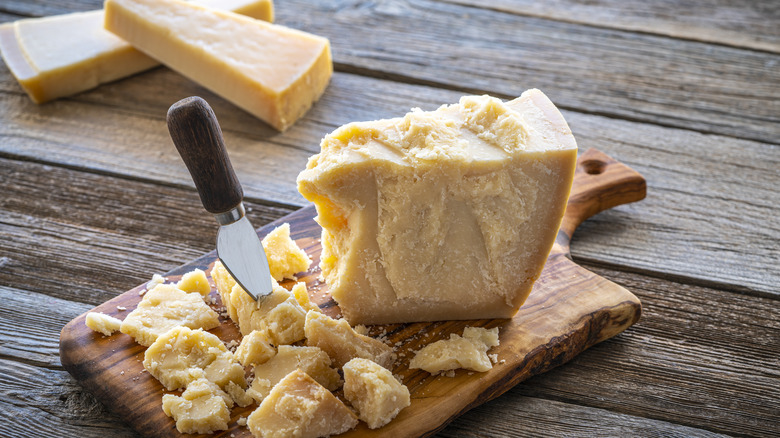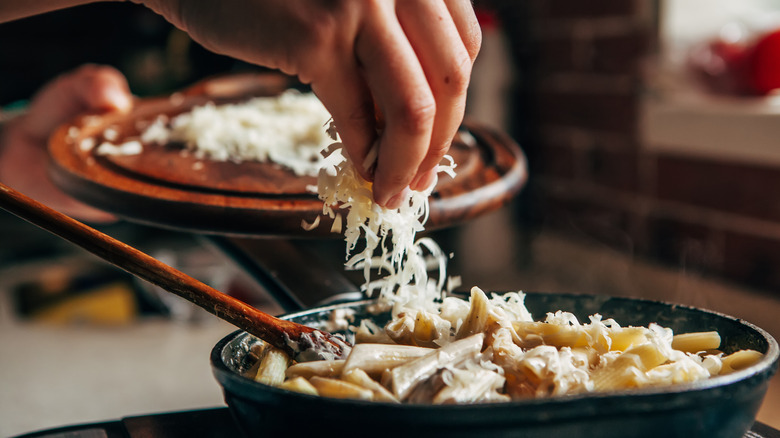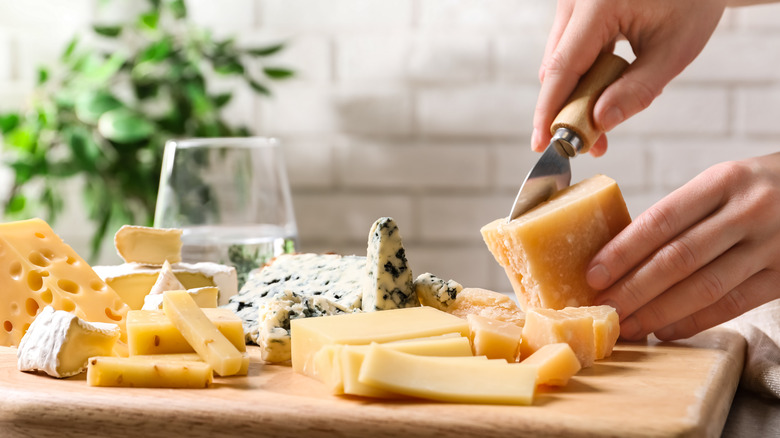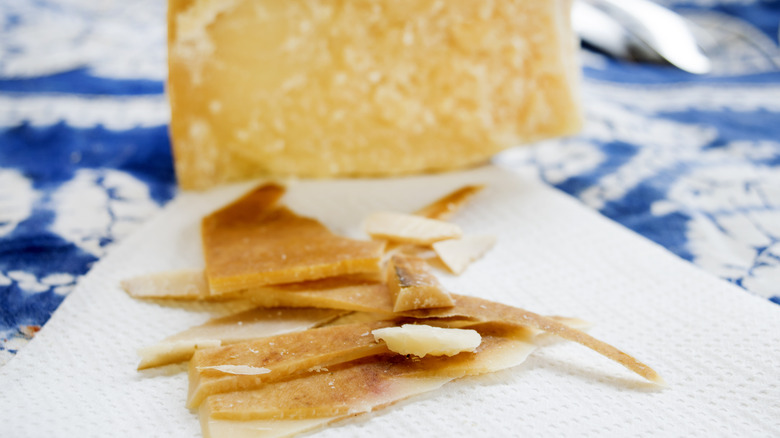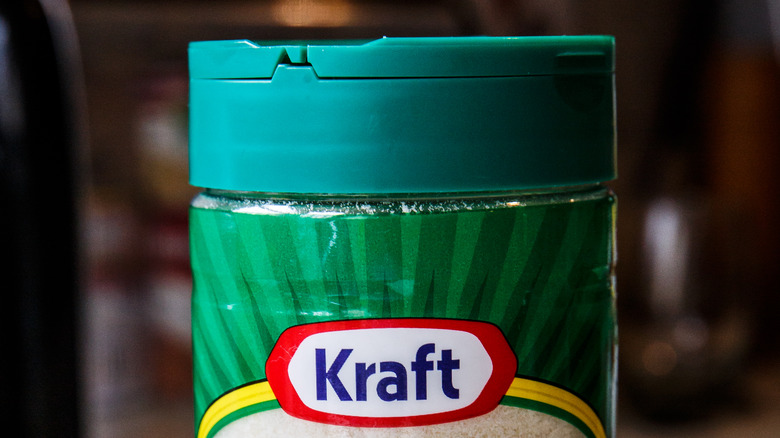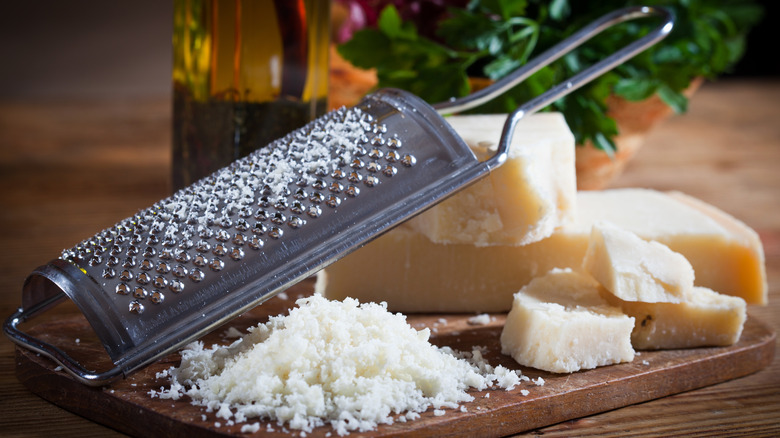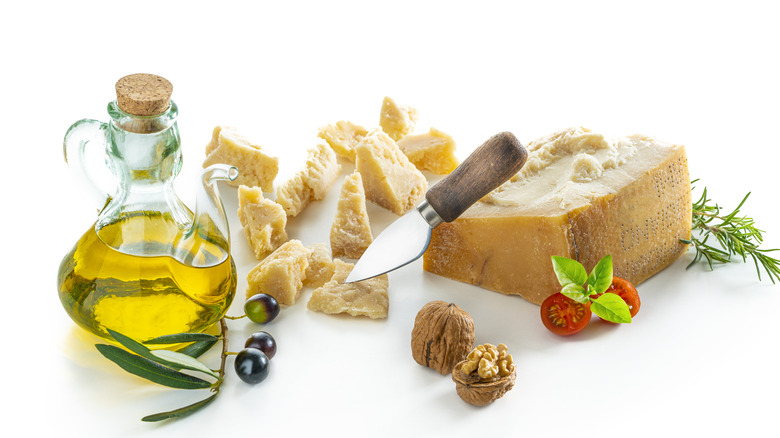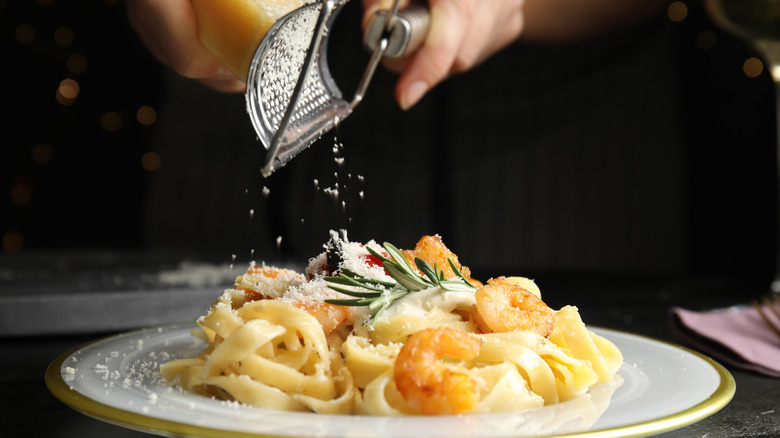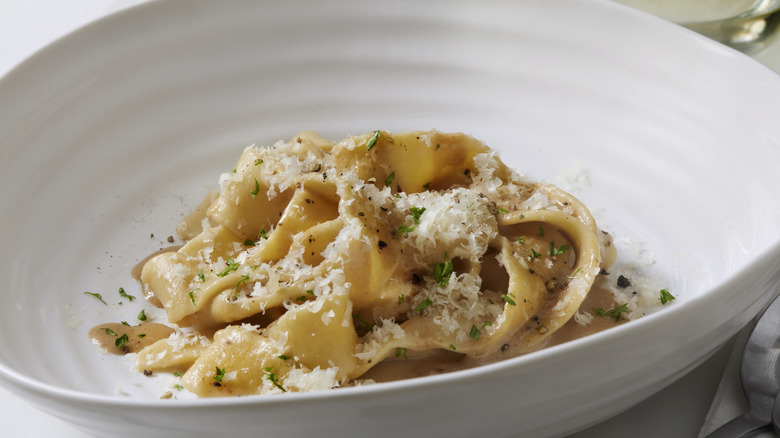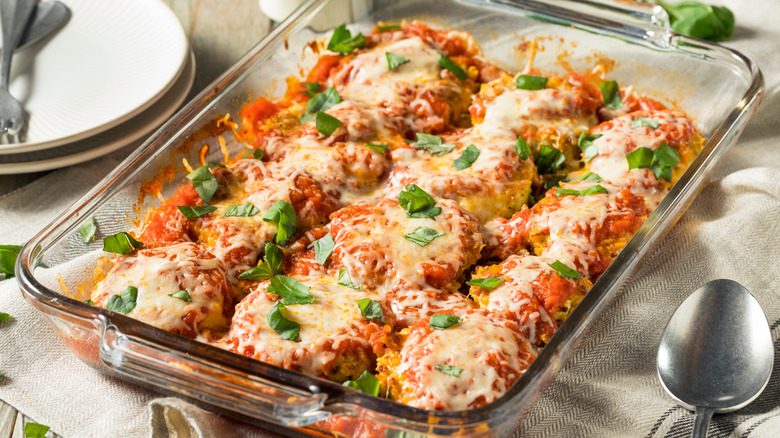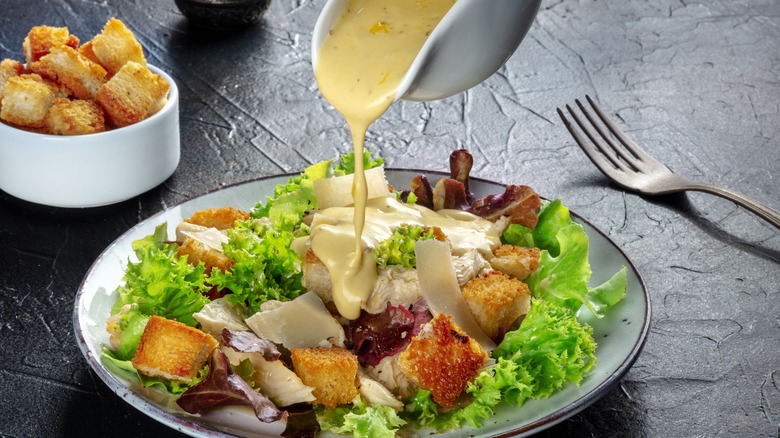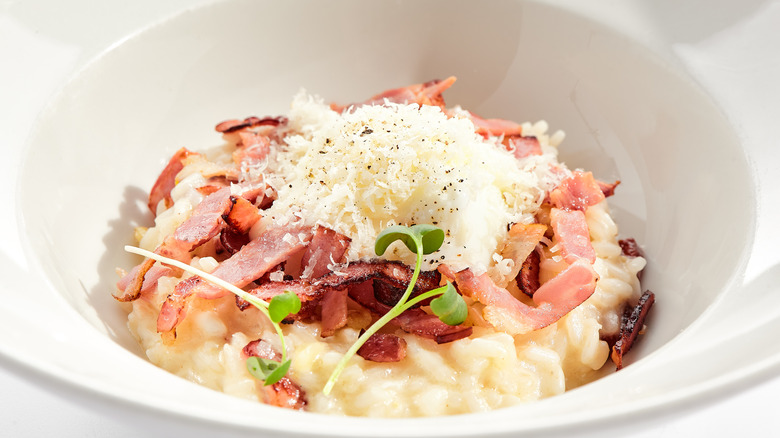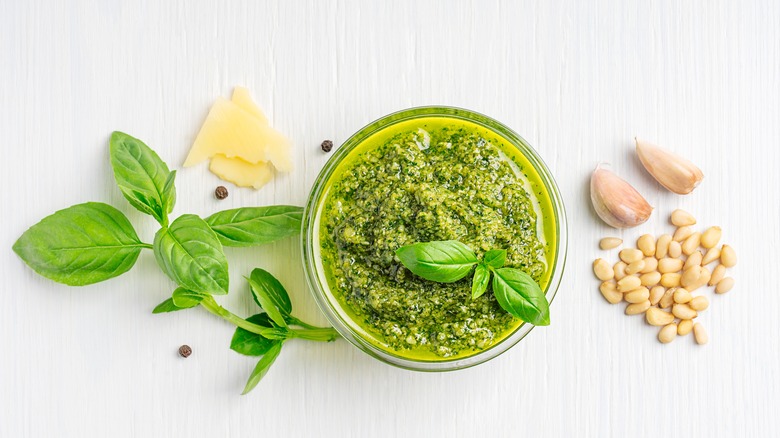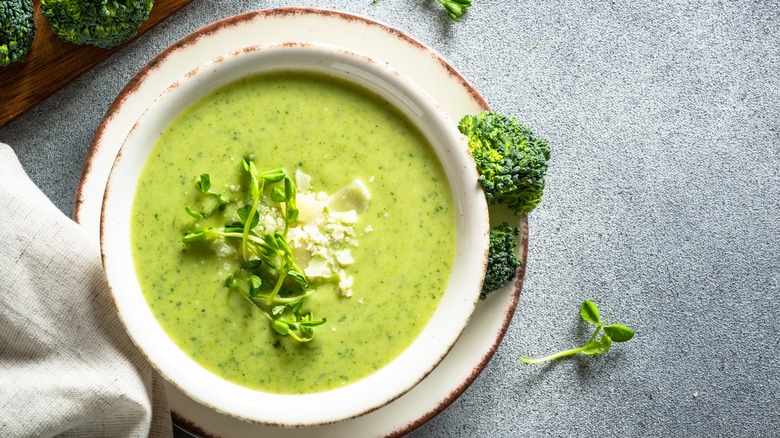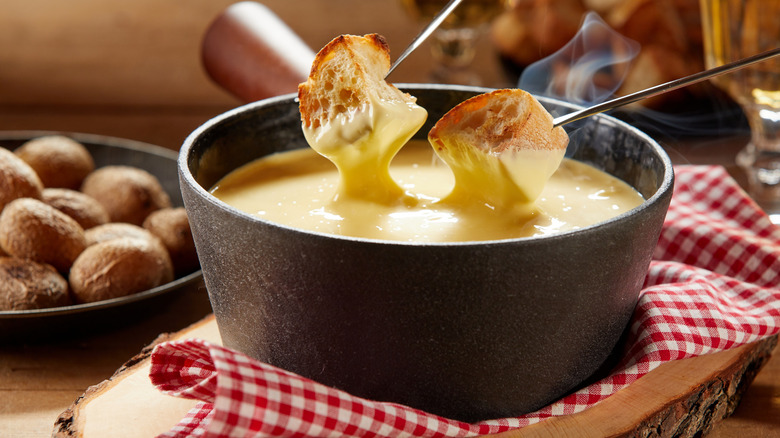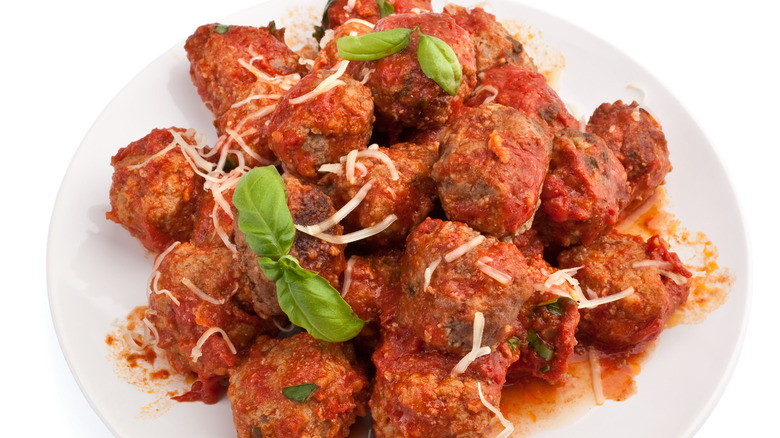15 Tips You Need When Cooking With Parmesan Cheese
For bold flavors and rich textures in your food, it has to be Parmesan cheese! This classic Italian cheese has been made for centuries, and it's no wonder it's still a staple in kitchens worldwide. Parmesan is produced from cow's milk and has an intense, sedgy aroma that can improve any dish, from pasta to risotto to soups.
In cooking with Parmesan, the possibilities are endless. From adding it to classic pasta dishes to using it as a topping for roasted vegetables, Parmesan's versatility is unmatched. Its flavor also pairs well with other ingredients, including garlic, herbs, and fruits like pears and figs. But be warned: not all Parmesan is created equal. For example, authentic Parmigiano Reggiano is a protected designation of origin (PDO) product, meaning it can only be produced in some areas of Italy using specific methods. So, next time you're at the grocery store, look for the PDO label to ensure you get the real deal.
Are you ready for a journey through the flavors of delicious Parmesan? Whether you're a seasoned fan or a newcomer to the cheese game, there's no better time to try this great-tasting Italian type.
Use fresh Parmesan cheese for the best flavor
Freshly grated Parmesan can be considered the king of all cheeses. It's no secret that this delight is an essential ingredient in many excellent dishes. Also, this Parmesan variety is better than the pre-grated kind for several reasons.
First, there's flavor. When you buy pre-grated Parmesan, it's often coated in anti-caking agents like cellulose powder or potato starch, dulling the cheese's natural flavor. Second, there's texture. Pre-grated Parmesan is dryer and has a finer texture, which is convenient but not so great for dishes that require a coarser, easier-to-melt cheese. When you grate your cheese, you can control the texture and size of the shreds, ensuring that your dish has the perfect Parmesan-to-pasta ratio. And don't forget about the price. Buying pre-grated cheese means purchasing a smaller amount for more money because the overall cost of pre-grated Parmesan is higher. If you purchase pre-grated Parmesan, you will lose the chance of sneaking a taste of a piece of cheese, and that's a genuine loss.
Learn about the different Parmesan types
If you enjoy Parmesan, you probably know that not all the varieties are equal. There are different Parmesan cheese types, each with its unique flavor profile.
First, we have Parmigiano Reggiano, the most premium Parmesan type. This cheese uses only three ingredients: milk, salt, and rennet. It's aged for at least 12 months, which gives it a buttery flavor and a grainy texture. It's perfect for grating over pasta or risotto or eating alone with a glass of wine. Next up, we have Grana Padano, often referred to as the "younger brother" of Parmigiano Reggiano. Like its older sibling, Grana Padano is made from milk, salt, and rennet, but it's aged for a shorter period, around nine months. The shorter aging time gives it a milder, sweeter flavor and a smoother texture. It's great for grating over salads or as a topping for pizza.
Finally, we have Parmesan cheese, the American version of Parmigiano Reggiano. It's often made using a combination of cow's milk and other varieties, and it's aged for a shorter period than Parmigiano Reggiano. As a result, it has a milder flavor and a creamier texture, making it a popular choice for recipes that require melted cheese.
Don't throw away the rinds
Parmesan cheese is a precious commodity. It's an essential ingredient in many dishes; the aroma makes your mouth water. Furthermore, the rind, which is often discarded, is an excellent way to get more out of your Parmesan cheese.
Parmesan rinds are a treasure trove of flavor. They're packed with umami-rich compounds that can add depth and complexity to your dishes. So, try to avoid throwing away your Parmesan rind. One way to use Parmesan rinds is to throw them into soups and stews. Then, simmer them in broth or sauce, and watch as they infuse your dish with their rich flavor. After that, you can chop them up, add them to risotto or pasta dishes, or even grill them and use them as a topping for salads or pizzas.
But perhaps the most effective way to use Parmesan rinds is to concoct a broth. You can create a rich, flavorful base for soups, stews, and sauces by simmering your peels in water. You can even freeze the broth in ice cube trays and use it as a quick flavor booster for all your cooking needs. As the broth simmers, the Parmesan rinds release their flavor and create a savory soup base. You can also add ingredients, such as carrots, celery, or herbs, to enhance the flavor even more.
Save the lid from your Parmesan shaker
Every bit of food or kitchen utensils counts in cooking. So, don't throw away the lid from your Parmesan shaker, as it's a handy little tool that can be repurposed in various ways.
It turns out that the cover from your Parmesan shaker is the ideal size for numerous other vessels, such as seasoning or mason jars. Remove the cap from the Parmesan shaker and screw it onto the new container, and you'll have a convenient, easy-to-use lid that will keep your spices or other ingredients fresh.
But that's not all. The lid from your cheese shaker can also help you store household items. A good example is baking soda, which you can use for baking, scrubbing pots and pans, and cleaning various surfaces. Cover a mason jar with a repurposed Parmesan shaker lid, and you will have a great way to sprinkle seeds, nuts, cinnamon sugar, or birdseed. A mason jar with a shaker cap is also great for sprinkling generous and even amounts of tenderizing spices on your steaks or BBQ dry rub over larger cuts.
Don't use Parmesan for vegetarian dishes
Though it is a beloved ingredient in many cuisines worldwide, Parmesan is unsuitable for vegetarians or vegans. The reason for this is the way Parmesan is made. When crafting traditional Parmesan cheese, animal rennet is used as a coagulant. Rennet is an enzyme found in the stomachs of young cows, sheep, and goats, and it's used to separate the curds from the whey in cheese-making. Unfortunately, this means Parmesan cheese is not vegetarian-friendly, as it contains animal products.
Even Parmesan labeled as "vegetarian" or "vegetarian-friendly" may still contain animal rennet, as microbial rennet (a vegetarian-friendly alternative) is not yet widespread in the cheese-making industry. The same goes for vegans. If a Parmesan is labeled as "plant-based" or "vegan," it may still contain casein, a milk protein used in cheese-making. So while finding vegetarian-friendly and vegan alternatives to Parmesan is possible, reading labels carefully and researching to ensure you're not consuming animal products is essential.
Invest in a specially designed knife
There's nothing like a beautiful Parmesan piece. But cutting it requires a special knife, so Parmesan isn't served in neatly sliced pieces like other cheeses. The need for special knives comes from the texture and density of Parmesan. Unlike softer cheeses, which can be sliced with a regular knife, Parmesan is hard and brittle. Therefore, attempting to cut it with a standard knife can cause uneven, crumbly pieces that don't do justice to the cheese's flavor and texture.
That's where a special Parmesan knife comes in. These knives, also known as Parmesan planes, are designed for cutting hard, dense cheeses like Parmesan. They feature a long, thin blade that's sharpened at an angle, allowing you to slice off thin, even pieces of cheese. A Parmesan knife makes cutting and serving Parmesan easier and allows you to appreciate the cheese's unique texture and flavor. However, slicing Parmesan with a regular knife can cause broken or crushed pieces that don't showcase the cheese's full potential.
Avoid combining Parmesan with seafood
The Parmesan cheese and pasta combination is classic and an all-time favorite, yet it may seem contradictory for you to know that there are some Italian dishes where adding Parmesan is a big no-no. In particular, seafood and Parmesan don't make the best pairing.
Parmesan has a strong, salty flavor that can overpower the delicate flavors of seafood. In dishes like a seafood risotto or linguine alle vongole, for example, adding it can mask the subtle aroma of the seafood and make the dish too heavy. In addition, Parmesan is a hard cheese that doesn't melt as fast as other varieties, which can cause a clumpy, unappetizing texture when combined with seafood. Parmesan can also make the broth too thick in dishes like seafood soups or stews.
Of course, there are other dishes where Parmesan is a perfect match for some seafood, such as spaghetti alle cozze (spaghetti with mussels). In these cases, Parmesan's robust and salty flavor complements the briny, savory taste of seafood.
Add Parmesan cheese to pasta for a nutty flavor
Among classic Italian pasta dishes, few can beat the simplicity and deliciousness of cacio e pepe. Great for a weeknight meal that needs less than 15 minutes to cook. This dish goes to the next level featuring Parmesan cheese can give it a rich and grassy flavor that thickens with the starch of pasta water.
To make this classic pasta dish, cook it in a pot of salted boiling water until it's al dente. Heat some olive oil in a large pan and add freshly ground black pepper, toasting it until fragrant. Next, add a ladleful of the pasta water and let it reduce. Once the pasta is done, transfer it to the pan, using tongs to toss it with the black pepper and pasta water. Next, add a generous amount of grated Parmesan cheese to the pan, stirring until it melts and forms a creamy sauce. The Parmesan adds a mineral, umami flavor to the dish, balancing the sharpness of the black pepper and the salinity of the pasta water.
Top roasted vegetables with Parmesan
Roasting vegetables is a simple and delicious way to bring out natural sweetness and flavor. Topping the over-bake with Parmesan cheese can add a turfy, savory finish to the top of your meal. Cut your veggies of choice, like eggplant or zucchini, into bite-sized pieces and toss them with olive oil and seasonings like salt, pepper, and garlic powder. Now you're ready.
If you want to roast vegetables with a tangy edge, consider a tomato sauce-based eggplant Parmesan. Avoid breading the eggplant when making it because it will soak up too much oil. Instead, arrange the veggies in a single layer on a baking sheet and roast them in the oven until they're tender and caramelized. Once the veggies are cooked, remove them from the oven and pour over tomato sauce, then sprinkle them with freshly grated Parmesan cheese. Return the baking sheet to the oven and broil the veggies until the cheese is melted and golden brown.
Make a classic Caesar dressing with Parmesan cheese
Caesar salad is a classic dish that food enthusiasts have enjoyed for decades. The secret to its great aroma is its dressing. The recipe for Caesar dressing typically includes mayonnaise, garlic, lemon juice, Parmesan cheese, and anchovies (for those who prefer them).
For a classic Caesar dressing with Parmesan cheese, stir until everything is incorporated. The Parmesan adds a rich flavor to the dressing, while the lemon juice and Worcestershire sauce provide a tangy, sour note that balances the creamy mayonnaise. The Dijon mustard adds a hint of spiciness and depth of flavor, while the garlic adds a spicy, savory taste. All these flavors work together harmoniously to create a delicious dressing that complements a fresh Caesar salad.
The dressing can be used immediately or stored in the refrigerator for later. When you're ready to serve your Caesar salad, drizzle the dressing over a bed of chopped romaine lettuce and sprinkle with croutons and additional Parmesan cheese for a finishing touch.
Mix Parmesan cheese into risotto for a cre1amy and flavorful dish
Risotto is a great idea when you're looking for a simple but delicious dinner idea and have the time for a bit of creation. The creamy, savory dish is a classic for a reason, and adding grated Parmesan cheese makes it even better.
When it comes to Parmesan risotto, you'll need arborio rice, a similarly authentic ingredient that is stickier and will be elevated when coated with grated Parmesan cheese. Chicken or vegetable broth, butter, onion, and white wine, are also some ingredients you'll need. Sautéing the onion in butter until it's soft and translucent, add the rice, and cook until it's coated with butter and slightly toasted. A slash of white wine, cooked until the aroma burns off, can add nuance. From there, add the broth, one ladleful at a time, and stir the rice until the liquid is absorbed before adding more. This process can take some time, but it's worth it for the creamy, tender texture of the finished risotto.
Finally, once the rice is cooked through and the liquid has been absorbed, it's time to add the Parmesan. Stir in a generous amount of grated cheese, then season with salt and black pepper. The result is a rich and aromatic risotto that's sure to satisfy. The flavor of Parmesan cheese is the perfect complement to the creamy texture of risotto, making it a classic pairing in Italian cuisine.
Bring an umami kick to your pesto sauce with Parmesan
Pesto is an Italian sauce staple in many kitchens. While traditional pesto calls for pecorino cheese, Parmesan can substitute for a somewhat different but equally delicious flavor. Here's a recipe for a classic basil pesto that incorporates Parmesan cheese.
A high-quality pest needs fresh basil leaves, as well as pine nuts, garlic cloves, extra-virgin olive oil, salt, and freshly ground black pepper to taste. Grated Parmesan cheese will help the mixture bind, and it will also add a fatty depth of flavor. In a food processor, pulse the basil, Parmesan, pine nuts, and garlic until finely chopped. Pour the olive oil while the machine runs until a smooth consistency is reached. Finally, add salt and pepper.
This pesto sauce is perfect for tossing with your favorite pasta, spread on a sandwich, or as a vegetable dip. The nuttiness of the Parmesan cheese adds layers to the sauce, while the basil and garlic provide a fresh and herbaceous accent. Combining these ingredients creates a creamy, slightly tangy sauce that's hard to resist.
Garnish soups and chilis with Parmesan
Parmesan cheese is a versatile ingredient that can add a unique level of flavor to soups while also imparting a changed texture. For instance, in a rustic Italian wedding soup recipe, grated Parmesan cheese is used as a garnish to bring out the hearty soup flavors and upgrade the mouthfeel before eventually melting to thicken the bowl.
To bring this soup together, cook onion, carrot, Parmesan rinds, and celery until softened. Next, add the chicken broth and the meatballs you browned in the oven. Everything will simmer for a while (until the meatballs are cooked), then you'll stir in cooked short pasta and simmer for a few more minutes. Before serving, ladle the soup into bowls and sprinkle with grated Parmesan cheese. As the cheese melts into the hot soup, it adds a flavor that complements the savory broth, sweet veggies, and rich meatballs. As mentioned, you'll also notice Parmesan provides a smooth texture and a milky taste to bring the dish together.
Combine Parmesan with white wine for a cheesy fondue
Parmesan cheese is not just for topping pasta or salad; it is also an excellent choice for fondue. Parmesan can be a top-tier choice for fondue because of its nutty flavor and sharpness.
One consideration with Parmesan fondue is to carefully grate the cheese, aiming for even shreddings. A microplane is recommended. You'll also want to toss it with cornstarch to help it melt and thicken evenly. Bring white wine and minced garlic to a simmer over medium heat in a fondue pot or heavy-bottomed saucepan. Gradually stir in the grated Parmesan cheese until it's smooth. Finish the fondue with a pinch of freshly grated nutmeg and black pepper.
Parmesan's rich, earthy, and fruity flavors pair with the tangy acidity of the wine and the subtle hint of garlic. When melted, the cheese also gives the fondue a creamy texture, perfect for dipping crusty bread, roasted vegetables, or cured meats. Some cheese fondue recipes call for only one type of cheese, but you can combine Parmesan with other varieties like Gruyere or Emmental for a more complex flavor. In addition, the saltiness and sharpness of Parmesan can balance out the mildness of different cheeses and add depth to the fondue.
Substitute breadcrumbs in meatballs and meatloaf with Parmesan for a flavor burst
Although they're a home cooking staple, meatballs, and meatloaf can be gourmet. With Parmesan cheese, you can transform these classic comfort dishes into flavorful and cheesy delights. This special Italian meatball recipe shows how Parmesan can take your meatballs to the next level.
Your meatballs will utilize egg with Parmesan for a binding effect, while chopped onions, minced garlic, and herbs season the mix with complementary pungency and bite. Forming the mixture in 2 to 3-inch diameter balls is a good size as it will allow even browning and moderate moisture. All you'll need after that is a baking sheet lined with parchment paper. In 25 minutes, you can have perfectly cooked meatballs held together by the star ingredient, Parmesan.
Meatballs often call for breadcrumbs, but the egg-Parmesan combo in this recipe is an excellent gluten-free substitute, adding flavor and texture to the meat.
